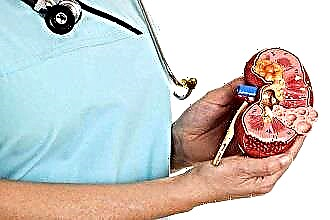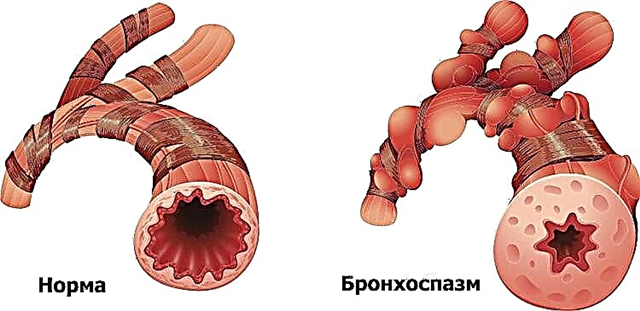Staphylococcus aureus refers to opportunistic bacteria. It lives on the skin and mucous membranes in 80% of people, but in small quantities or sporadically. In order for the disease to become active, it is necessary to create certain conditions. Cell activation and their rapid division occurs due to a drop in immunity and the development of bacterial infections. Treatment of Staphylococcus aureus in the nose is selected by the doctor after a detailed study of all the features of the pathology.
Features and danger of bacteria
 Staphylococcus aureus is a gram-positive bacteria that are round in shape and are capable of very rapid division. They release toxins that kill cells, as well as lipase. Lipase is an enzyme that breaks down fats and breaks down the sebaceous plugs of hair follicles. Because of this, pustules form on the skin and mucous membranes.
Staphylococcus aureus is a gram-positive bacteria that are round in shape and are capable of very rapid division. They release toxins that kill cells, as well as lipase. Lipase is an enzyme that breaks down fats and breaks down the sebaceous plugs of hair follicles. Because of this, pustules form on the skin and mucous membranes.
In adults and children, the infection is most often located in the nasal passages, armpits, it can actively develop in the groin and vagina. Bacteria spread to almost all tissues and organs, causing general intoxication of the body and provoking a number of such serious diseases:
- chronic rhinitis and sinusitis;
- mucosal atrophy;
- otitis;
- sepsis;
- meningitis;
- diseases of the gastrointestinal tract (if it enters the stomach with mucus);
- pneumonia;
- toxic shock.
Problematic
 Nowadays, treating Staphylococcus aureus is quite difficult, as it is resistant to most antibiotics. Bacteria do not respond to the immune response, since they enter the active phase due to a decrease in the body's protective functions, antibodies simply cannot cope with the infection on their own. In addition, pathogens are quite "tenacious", they do not die in such conditions:
Nowadays, treating Staphylococcus aureus is quite difficult, as it is resistant to most antibiotics. Bacteria do not respond to the immune response, since they enter the active phase due to a decrease in the body's protective functions, antibodies simply cannot cope with the infection on their own. In addition, pathogens are quite "tenacious", they do not die in such conditions:
- when dried;
- remain active for more than 12 hours when exposed to ultraviolet rays;
- can remain viable at a temperature of 150 ᵒС for more than 10 minutes;
- do not die in pure ethyl alcohol for about 10 minutes;
- do not react to hydrogen peroxide, as they produce the enzyme catalase, which releases oxygen from the peroxide, which is absorbed by staphylococcus;
- live in a salty environment, therefore they can be contained in human sweat.
When Staphylococcus aureus appears in the nose, treatment can be difficult, as bacteria very quickly adapt to different drugs and develop immunity to them.
Microorganisms show resistance to antibiotics of the penicillin group. However, when this natural component was replaced by a chemical analogue - mecillin, the situation repeated itself - with prolonged use of drugs based on it, the pathogenic microflora develops resistance. The same thing happens with products based on vancomecin and glycopeptide.
The subtleties of choosing therapy
 Only a doctor should choose how to treat a bacterial infection. Staphylococcal otitis media, rhinitis and other diseases are quite difficult to treat, since microorganisms in most cases cannot be treated with antibiotics. To find out the reaction to certain drugs, the doctor does tests. It is very important to choose the right therapy, as failure can result in serious consequences for the patient.
Only a doctor should choose how to treat a bacterial infection. Staphylococcal otitis media, rhinitis and other diseases are quite difficult to treat, since microorganisms in most cases cannot be treated with antibiotics. To find out the reaction to certain drugs, the doctor does tests. It is very important to choose the right therapy, as failure can result in serious consequences for the patient.
If you do not carry out tests for the reaction of staphylococcus, then the wrong scheme will lead to the appearance of super-resistant strains, and this can also occur from the frequent and unjustified use of potent antibacterial agents.
Drugs that do not have a detrimental effect on bacteria can only aggravate the situation, the infection will spread through the blood throughout the body and cause serious complications. Before curing a disease, you need to make sure that pathogenic microorganisms respond adequately to the selected funds.
Treatment of the disease
After a detailed diagnosis and testing, the doctor prescribes treatment for Staphylococcus aureus. Complex therapy consists of a number of antibacterial local and systemic agents, drugs with antiseptic properties for external treatment of the nose, immunostimulants. Let's take a closer look at what medications can have a positive effect.
Local means
 Such drugs are produced in drops, ointments can also be prescribed. They act directly on bacteria, suppressing their activity or completely destroying them. You can use the following tools:
Such drugs are produced in drops, ointments can also be prescribed. They act directly on bacteria, suppressing their activity or completely destroying them. You can use the following tools:
- Ointment "Bactroban". Active even against staphylococci, which have developed resistance to methicillin-containing drugs. It is necessary to apply the product on the inside of the nostrils, without climbing far up, the treatment is carried out 2 times a day.
- Spray "Bioparox". An effective topical antibiotic, indicated for use even by pregnant women. A special nozzle is included with the spray, with the help of which the agent is injected into the nasal cavity. Microparticles of the drug penetrate deep into the passages and even into the paranasal sinuses, so they can be used to treat almost the entire infected surface at a time. The spray not only kills bacteria, but also relieves inflammation, which greatly relieves the patient's condition in a short time.
Systemic antibiotics
Systemic agents are taken orally or intramuscularly, the course lasts a long time. How to treat the disease, according to what scheme and for how long, only the doctor decides. An overdose of drugs can be very dangerous to health, therefore it is important to follow all the recommendations of a specialist. Active against Staphylococcus aureus can be drugs such as Unazin, Oxacillin, Ceftriaxone, Amoxiclav and others.
Antiseptics
It is necessary to treat the nasal cavity with antiseptics so that staphylococcus does not have the opportunity to multiply. To do this, use special tools, which we will familiarize ourselves with in more detail.
| A drug | Mechanism of action | Application features |
|---|---|---|
| "Chlorophyllipt" | It has a detrimental effect on bacteria, destroying some of their strains, and promotes the healing of wounds on the mucous membrane. | Compresses are made from dissolved tablets or oil, turundas are moistened in a product and placed in the nose. |
| "Brilliant greens" | Staphylococci are sensitive to this drug, they immediately die from it. | You can only process the skin around the nose, the agent is not intended for mucous membranes, it can burn them. |
| "Bacteriophages" | Phage viruses are capable of destroying even staphylococci that do not respond to antibiotics. | The liquid, which contains staphylococcal bacteriophages, is taken orally, compresses are also made from it, wetting the turundas and placing them in the nostrils, the course of treatment lasts no more than 10 days. |
| "Hydrogen peroxide" | In relation to staphylococcus bacteria, it is ineffective, but it helps very well to fight purulent wounds, disinfects them. | A 3% solution is diluted with boiled chilled water in a ratio of 1:11, so as not to burn the mucous membrane, make compresses or rinses. |
| Ichthyolka ("Vishnevsky's Ointment) | Accelerates the healing of already disinfected areas. | Apply to mucous membranes or skin. |
Immunomodulators
Enhancing protective functions is one of the most important tasks of therapy. Immunity can be strengthened with the help of such means as "Taktivin" (immunostimulatory peptide), "Polyoxidonium" (synthetic immunomodulator), "Immunal", "IRS-10" (nasal drops). Also, the patient is shown vitamin and mineral complexes. As soon as the body's defenses return to normal, the disease will begin to recede.
Treatment with folk remedies
In some situations, folk remedies give a good result. However, do not forget that they cannot replace the drug therapy prescribed by a doctor. You should also be careful with the choice of recipes, since the composition may include substances that cause allergies.
 Let's consider several methods of treatment:
Let's consider several methods of treatment:
- Parsley and celery. Bacteria die from exposure to substances in these plants. In the chronic course of the disease, it is useful to consume juice from the roots. To prepare the medicine, you need to grind the ingredients and squeeze the juice out of them, take 2 parts of parsley juice for 1 part of celery juice, mix, take 1 teaspoon 40 minutes before the meal.
- Infusion for washing. Prepare an infusion of dried burdock root and medicinal comfrey. We take half a tablespoon of ingredients, grind well, pour a glass of boiling water and leave for half an hour. We filter the finished chilled infusion and use it to rinse the nose.
- Decoction for oral administration. We take 2 teaspoons of dried burdock and echinacea roots, pour 4 cups of boiling water and cook over low heat for 20 minutes. We filter the resulting broth, take 0.5 cups 3 times a day.
Caution in treatment
 When treating Staphylococcus aureus, you should be careful about the choice of drugs and folk remedies. Antibiotics can have serious side effects as they are considered powerful medications. With extreme caution, they are prescribed to children, pregnant women and the elderly who have chronic diseases.
When treating Staphylococcus aureus, you should be careful about the choice of drugs and folk remedies. Antibiotics can have serious side effects as they are considered powerful medications. With extreme caution, they are prescribed to children, pregnant women and the elderly who have chronic diseases.
Medicinal plants also cannot be completely safe for consumption. The dosage of folk remedies for children will be less than for adults.
If there is an allergy to any substances, the patient should make a test before starting therapy. Biologically active components are absorbed in large quantities by the body, therefore in some cases they can be hazardous to health.
Let's summarize
Staphylococcus aureus lives on the skin and mucous membranes of most people and is absolutely safe for health until it enters the active stage. Treating this disease is quite difficult, as bacteria quickly develop resistance to even the most powerful antibiotics.
However, complex therapy aimed at suppressing pathogens and increasing immunity will help to cope with the problem. If pustules are found on the nasal mucosa and on the skin around it, be sure to consult a doctor to avoid serious complications.



